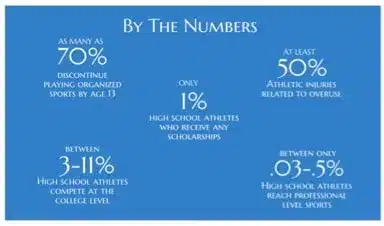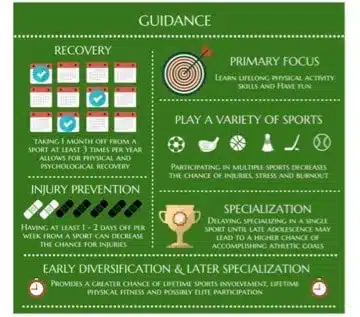-Mythbusting early sports specialization amongst youth aged kids
Well we’ve reached another school year, the leaves are starting to change and pumpkin spice everything is here. We at Specialized Physical Therapy are happy to kick off Physical Therapy Month with a discussion on an important topic. Early sports specialization is defined by the American Orthopaedic Society for Sports Medicine as follows: 1. Participation in intensive training and/or competition in organized spots greater than 8 months per year. 2. Participation in one sport to the exclusion of participation in other sport and 3. Involving prepubertal (less than age 12) children. In a survey of 3090 athletes across the major competitive levels, current high school athletes are specializing about two years earlier than current collegiate and professional athletes.2 While two years may seem insignificant, it may mean missed opportunity for key developmental periods to develop proper movement patterns in favor of becoming better at that individual sport. It is generally accepted that kids are getting more competitive than ever, we are bringing you the evidence to go against current trends and that earlier sports specialization is doing more harm than good for your athletes.
This graphic is from the American Academy of Pediatrics. While it is widely known that athletic scholarships are extremely competitive, what should immediately jump out to you is that overuse injuries as well as burnout are increasing more than ever in the current athletic environment.

Who is to blame? Quick Answer: Everyone but the athlete
The 10,000 hour rule: This may have been incorrectly used and glorified in the media as the origin was from previous studies evaluating the formula to chess players’ success.1 There are many factors that must be taken into account in order to attain elite status. From unique physiologic qualities to understanding that young athletes must learn important fundamental physical movement skills that transfer to multiple sports.1 Therefore, it may be possible to achieve elite status from an accumulation of other activities and not just sport specific training.
The loss of deliberate practice: A shift from youth-driven or free play has shifted to more structured parent and coach driven activities. It is important to recognize that playing sports without the consistent intervention of coaches (before age 13) has been identified as necessary to develop essential skills.3 Many professional athletes will often say that their best memories as a kid were playing pickup games without the pressure of a parent or coach where they really fell in love with their respective sports. Also, it is only in late adolescence that children may develop the necessary skills needed to invest in highly specialized training and understand the costs/benefits of intense focus on one sport. 3
Earlier recruitment: College recruitment has been reported as starting from as early as sixth grade.3 This has created unnecessary pressure for children and according to the US Olympic Committee are at a developmental stage where they are just starting to moving from the Discover, Learn, and Play stage to the Develop and Challenge stage.3 In multiple consensus statements provided in this blog post, there must be a tempering of expectations during competitive events and the level of skill necessary at each age level.
Still don’t agree:
There were 322 athletes invited to the 2015 NFL Scouting Combine, 7% of whom played multiple sports in high school and 13% of whom only played football1
Watch Sidney Crosby, considered the best NHL player right now, display amazing footwork on the ice and was a former soccer player in his youth: https://www.youtube.com/watch?v=0DDYIBLUZxk&t=310s
Recommendations:

*Sidenote: It is unclear whether high risk sports such as figure skating, gymnastics and diving poses a risk for long term health and well being as there are conflicting reports.1
References:
- Brenner, J. S. (2016). Sports Specialization and intensive training in young athletes. Pediatrics, 138(3), e20162148.
- Buckley, P. S., Bishop, M., Kane, P., Ciccotti, M. C., Selverian, S., Exume, D., … & Ciccotti, M. G. (2017). Early Single-Sport Specialization: A Survey of 3090 High School, Collegiate, and Professional Athletes. Orthopaedic Journal of Sports Medicine, 5(7), 2325967117703944.
- LaPrade, R. F., Agel, J., Baker, J., Brenner, J. S., Cordasco, F. A., Côté, J., … & Hewett, T. E. (2016). AOSSM early sport specialization consensus statement. Orthopaedic journal of sports medicine, 4(4), 2325967116644241.



